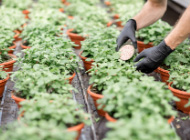
Aside from water and sunlight, plants require sufficient nourishment grow efficiently. Like humans, they need essential vitamins and minerals for optimum growth. Thus, it is recommended to use fertilisers.
Fertilisers are materials from natural or synthetic substances that are put on soil in order to supply plant nutrients. To know more about fertilisers, below are some information that can be useful for you.
Classifications of fertiliser
- Organic (natural) fertilisers
These fertilisers came from living and dead particles in organic soil. Living matters in the soil can be insects, earthworms and micro organisms. On the other hand, dead particles can be decaying remains of dead plants and animals.
- Chemical (synthetic) fertilisers
Chemical fertilisers are derived from naturally occurring chemicals and in organic materials such as rocks and petroleum products. These materials are usually refined to extract nutrients. Below are 2 types of synthetic fertilisers.
Simple (Straight) fertiliser
Simple fertilisers are intended to supply only 1 nutrient element. These elements can be:
- Nitrogen (N) – helps plants grow effectively and produce foliage
- Phosphorous (P) – promotes cell development, improves vitality and increases seed size
- Potassium (K)– stimulate healthy root growth, flower and fruit formation, provides diseases resistance
Mixed fertiliser
Mixed fertilisers are two or more straight fertilisers mixed together to supply two or more major elements. There are 2 types of fertiliser mixtures.
Types of fertilisers mixtures
- Open formula fertiliser mixture
Manufacturers of mixed fertilisers disclose names and quantities of straight fertilisers that are components of the mixture.
- Closed formula fertilisers mixture
Unlike open formula, closed formula mixture producers do not disclose the names and quantities of straight fertilisers.
In this matter, some people tend to use fertiliser mixtures for their plants. Read more below to know why.
Why is mixed fertiliser better than other fertilisers?
Using mixed fertilisers for your plants can be useful to gardeners and nurserymen. Listed below are some benefits of using fertiliser mixtures.
- Improvement of plants can occur within days after mixed fertilisers are used.
- It requires less labour than mixing various components separately.
- Residual acidity of fertiliser can be controlled by treating the acidity of the components in the mixture.
- Exact ratio of nutrients can be utilised as desired.
- Cost-effective – Comparing to organic fertilisers, mixed fertilisers have more concentrated level of nutrients per weight of product.
Utilising mixed fertilisers has more benefits than other fertilisers. To ensure the quality of the fertilisers, raw materials should be handled well and maintained in good condition.
There are various ways of handling fertilisers. One of the most common methods is manual handling.
Manual handling of fertilisers
Manual tasks such as packing of fertilisers should be managed carefully. Moreover, manual handling can be appropriate if you are just starting a nursery or garden. However, if you have a medium to large-sized nursery, manual handling might not be applicable for you. Here are a few downsides of utilising manual handling.
- Manual handling is relatively slow.
- Manual handling system cannot be programmed to do many tasks and therefore not economical to use.
- Manual handling system can be inaccurate.
- Manual handling can cause fatigue and back injuries to workers.
For this reason, utilising bagging machines can simplify manual tasks such as filling fertiliser into bags.
Utilising bagging machines
Most nursery business owners and managers often use an effective fertiliser bagging machine to store and pack fertiliser mixtures. Some advantages of using it are convenience and flexibility. Certain fertiliser bagging equipment can also pack a large volume of fertiliser at any time. After packing, fertiliser bags are now ready for distribution.
While fertilisers are being packed, it should also be stored and handled well to avoid unnecessary accidents and injuries.
Proper handling and distribution of fertilisers
There are certain types of fertilisers that can be hazardous when handled incorrectly. For instance, ammonium nitrate (AN) can cause fire and explosion due to oxidising nature. Thus, this type of fertiliser should be handled and stored properly.
Incorrect usage of fertiliser can also result in some health risks like skin irritation and even blindness. Moreover, fertilisers can be exposed to risks of product loss, pollution, road safety issues and environmental hazards while it is stored, handled, and transported. Likewise, when fertilisers are packed in their designated bags and sacks, using an appropriate bagging equipment is recommended.
Quality control
To obtain high-quality fertilisers, manufacturers should monitor the product at every stage during production. Some of the features that have been tested include appearance, density, pH level, and melting point.
Conclusion
Fertilisers are essential to supply nourishment to your growing plants. However, if it is handled improperly, it can also cause loss of nourishment which will affect your plants’ growth. Thus, proper handling of fertiliser should be considered. A good bagging machine should be utilised to effectively pack fertiliser mixtures.
Here is an example of leading manufacturer in Australia which has been producing high-quality bagging machine. It can store and pack a variety of materials such as potting mix, sand, soil, manure, etc.







